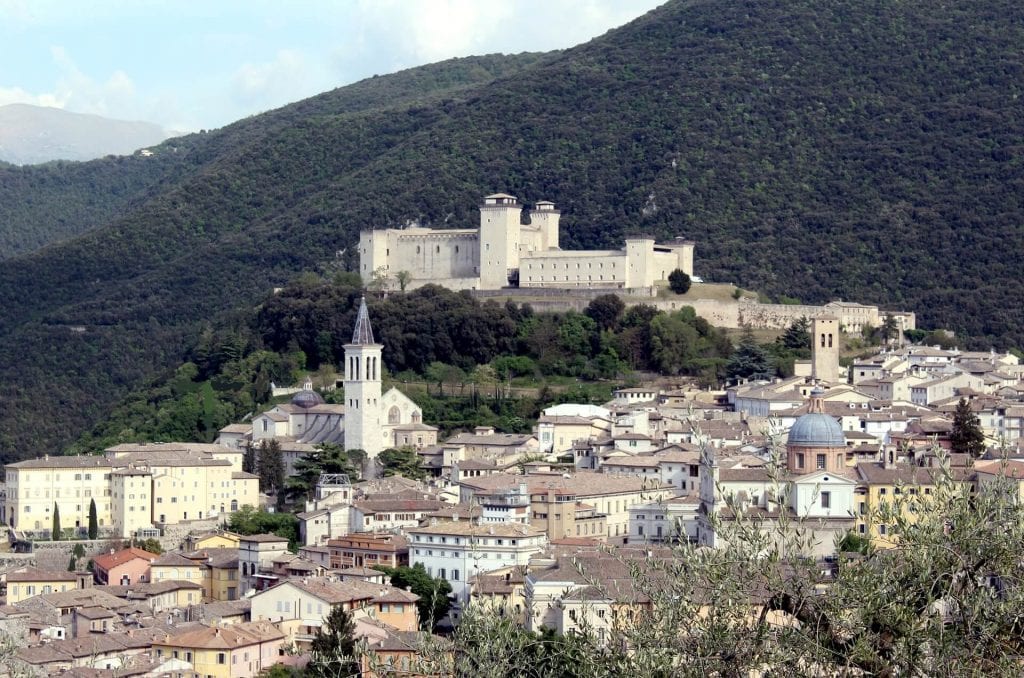Spoleto is an ancient city in the Italian province of Perugia in east-central Umbria on a foothill of the Apennines.
Located at the head of a large, broad valley, surrounded by mountains, Spoleto has long occupied a strategic geographical position. It appears to have been an important town to the original Umbri tribes, who built walls around their settlement in the 5th century BC, some of which are visible today.
The first historical mention of Spoletium is the notice of the foundation of a colony there in 241 BC; and it was still, according to Cicero “colonia latina in primis firma et illustris: a Latin colony in” 95 BC.
Owing to its elevated position Spoleto was an important stronghold during the Vandal and Gothic wars
Under the Lombards, Spoleto became the capital of an independent duchy, the Duchy of Spoleto (from 570), and its dukes ruled a considerable part of central Italy.
In 774 it became part of Holy Roman Empire.
Several of its dukes, mainly during the late 9th Century, rose to wear the crown of that Empire. Together with other fiefs, it was bequeathed to Pope Gregory VII by the powerful countess Matilda of Tuscany, but for some time struggled to maintain its independence. In 1155 it was destroyed by Frederick Barbarossa. In 1213 it was definitively occupied by Pope Gregory IX. During the absence of the papal court in Avignon, it was prey to the struggles between Guelphs and Ghibellines, until in 1354 Cardinal Albornoz brought it once more under the authority of the Papal States.
Main Sights
The Roman theater, largely rebuilt. The stage is occupied by the former church of St. Agatha, currently housing the National Archaeological Museum.
Ponte Sanguinario (“bloody bridge”), a Roman bridge 1st century BC.
The name is traditionally attributed to the persecutions of Christians in the nearby amphiteatre. The majestic Rocca Albornoziana fortress, built in 1359–1370 by the architect Matteo Gattapone of Gubbio for Cardinal Albornoz. It has six sturdy towers which formed two distinct inner spaces: the Cortile delle Armi, for the troops, and the Cortile d’onore for the use of the city’s governor.
The latter courtyard is surrounded by a two-floor porch. The rooms include the Camera Pinta (“Painted Room”) with noteworthy 15th‑century frescoes. After having resisted many sieges, the Rocca was turned into a jail in 1800 and used as such until the late 20th century.
After extensive renovation it was reopened as a museum in 2007.

Duomo (Cathedral) of S. Maria Assunta: Construction of the Duomo begun around 1175 and completed in 1227. The Romanesque edifice contains the tomb of Filippo Lippi, who died in Spoleto in 1469, designed by his son Filippino Lippi.
The church also houses a manuscript letter by Saint Francis of Assisi.
San Pietro extra Moenia: This church was founded in 419 to house the supposed chains that once bound St Peter. It was built over an ancient necropolis. Reconstruction occurred from the 12th century to the 15th century, when a remarkable Romanesque façade was added: this has three doors with rose-windows, with a splendid relief decoration by local artists, portraying stories of the life of St. Peter.
Together with S. Rufino in Assisi, it is the finest extant specimen of Umbrian Romanesque. The church is preceded by a large staircase.
In the 17th century the interior, having a basilica plan with a nave, two aisles, and an elliptical dome, was remade in Baroque style.



